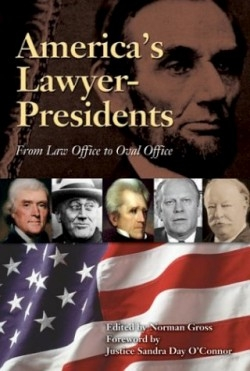America's Lawyer-Presidents
From Law Office to Oval Office
Biographies of presidents tend to emphasize their political and personal lives, rather than their professional careers. This book, which accompanies a traveling exhibit, a website, and a series of special programs, helps to fill this informational gap. The editor, who worked for more than thirty years as the American Bar Association’s director of public education programs, is director of the ABA Museum of Law in Chicago. He has also published articles on law-related education, ABA history, and famous American trials.
Gross discusses the legal careers of the twenty-five of forty-three presidents who were attorneys and, most notably, shows how these careers influenced the presidents? administrations. The anthology is divided into sections that parallel traditional American historical periods: colonial, antebellum, Lincoln era, Gilded Age, early twentieth century, and modern.
Distinguished Stanford University law professor Lawrence Friedman provides a two-page description of the evolution of American law and the legal system during each period. Following these are eight ten-page articles about each lawyer-president who served during the respective historical eras. Contributors include such first-rate scholars as Howard Jones on John Quincy Adams, Jean Baker on James Buchanan, Thomas Reeves on Chester A. Arthur, and Lewis Gould on William McKinley. Also included are a profusion of photographs, sidebars of fascinating legal anecdotes, and a foreword by Supreme Court Justice Sandra Day O’Connor.
The book brims with interesting facts, such as how John Adams and Thomas Jefferson drew on their legal experience to conceptualize and write the Declaration of Independence. Also, based on his legal expertise, John Quincy Adams concluded that slavery was incompatible with the Declaration’s guarantee of human rights. The reader gains an understanding of how slave laws were a uniquely American evil and how slavery and its tragic legacy divided the United States from the time of its founding and still continues to haunt the country. Paul Finkelman claims in his article that Lincoln, who is generally regarded by historians as America’s greatest president, spent more years practicing law (1836?1861) than any other lawyer-president. Also demonstrated is how American law is rooted in English law, and was changed to become meaningful to American habits and customs.
This book, like the exhibit it accompanies, is best enjoyed by meandering through it at a leisurely pace. Although legalese rears up at times and many precedent-setting law cases are mentioned too vaguely, this is a worthy and insightful appraisal of the relationship between the legal profession and the presidency. It is a welcome addition to the scholar’s bookcase and the general reader’s coffee table
Reviewed by
Karl Helicher
Disclosure: This article is not an endorsement, but a review. The publisher of this book provided free copies of the book to have their book reviewed by a professional reviewer. No fee was paid by the publisher for this review. Foreword Reviews only recommends books that we love. Foreword Magazine, Inc. is disclosing this in accordance with the Federal Trade Commission’s 16 CFR, Part 255.

